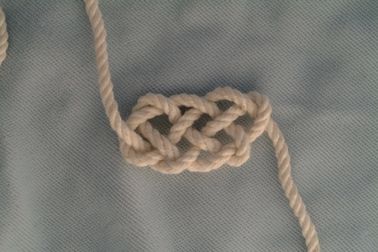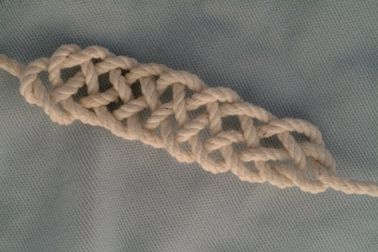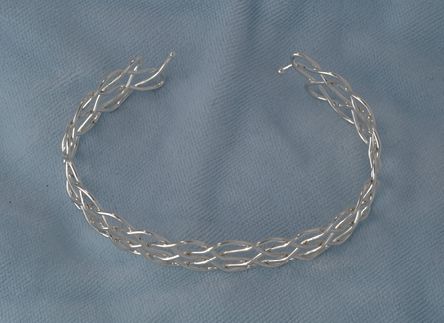|
If you've looked around the site a bit, you realize that I don't like even numbers much at all, and only work with them when I have to. Most of my Turk's Head knots have five leads, or seven, or nine, etc., all odd numbers. Best of all, in my opinion, is a knot with all prime numbers, a 5x11, for example, or a 7x13. An exception, an unavoidable one, arises when I create a Prolong Knot of any size, because the wire has to travel end to end, and return, three times. Two times three, for a six-lead weave, and no getting away from the even number regardless of how many loops along the edge. I've been trying to come up with another way, and perhaps this next knot will be it.
|
 I don't know what to call this knot -- it's definitely not a Prolong Knot, anyway. I'm somewhat reminded of the slipknot chains that practically everyone has tied at one time or another, where each slip knot gets a loop of the running part tucked through it before being snugged down, and the knot can be pulled apart quickly and easily with each loop coming out of and releasing the next loop in line. All one had to do to "lock" the chain was to draw the entire end through, instead of a loop. The closest I can come to my knot in The Ashley Book Of Knots is #576, "A flat lanyard knot based on Five-Strand French Sinnet", but mine doesn't have any lines crossing two levels to return through the body, as that one does.
I don't know what to call this knot -- it's definitely not a Prolong Knot, anyway. I'm somewhat reminded of the slipknot chains that practically everyone has tied at one time or another, where each slip knot gets a loop of the running part tucked through it before being snugged down, and the knot can be pulled apart quickly and easily with each loop coming out of and releasing the next loop in line. All one had to do to "lock" the chain was to draw the entire end through, instead of a loop. The closest I can come to my knot in The Ashley Book Of Knots is #576, "A flat lanyard knot based on Five-Strand French Sinnet", but mine doesn't have any lines crossing two levels to return through the body, as that one does.
|
 Unlike the slipknot chain, which grows as long as you keep pulling the loops through, this knot has to be tied complete, a unified whole with the line coming in one end, zigzagging a set number of times to the other end, returning upon itself, advancing again, returning one last time, and then proceeding in the original direction to complete the knot and continue on its way. The simple basket-weave pattern, over one and under one, is clean and elegant, and though it can easily become distorted in a string knot, will probably hold very well when it's executed in gold or silver.
Unlike the slipknot chain, which grows as long as you keep pulling the loops through, this knot has to be tied complete, a unified whole with the line coming in one end, zigzagging a set number of times to the other end, returning upon itself, advancing again, returning one last time, and then proceeding in the original direction to complete the knot and continue on its way. The simple basket-weave pattern, over one and under one, is clean and elegant, and though it can easily become distorted in a string knot, will probably hold very well when it's executed in gold or silver.
|
|
I am picturing this knot being used in a number of different ways. The simplest one, at top, might very well have one end of the wire extended and bent back upon itself as a French Hook, for an earring. The next one is too long (?) for that, but too short for much else, however I suspect that much longer ones will be possible, and the ends can be bent into short smooth hooks for a bracelet or necklace catch. Thus, this knot fulfils my strong preference for single-line knots (all one piece of wire), odd numbers of leads, in at least one dimension, and in addition, it allows the person who wishes to wear it to put it on and take it off in a comfortable and understandable way, unlike some of my more peculiar pieces. (I've got a chain that even I have trouble with, and I've been opening and closing the clasp for years . . . when I could find it!)
|

Here's a bracelet in pure silver, with nineteen loops along the edge. I touched the ends of the wire with the torch to ball them up, so there's nothing sharp, but I can see that it would probably tangle in knitted stuff. Still, it could be just right for someone.
|
|
|
|